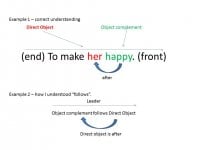HeartShape
Member
- Joined
- Feb 27, 2018
- Member Type
- Student or Learner
- Native Language
- English
- Home Country
- UK
- Current Location
- UK
I have a question I want to clarify. In the following sentence:
Explanation sentence: "An object complement is a noun, a pronoun, or an adjective which follows a direct object to rename it or state what it has become."
"To make her happy". her=direct object happy=object complement
I would have thought when the word "follows" is used "happy" would come before "her"; isn't that the meaning?
Example: "To make happy her" (sounds wrong I know but it's just a demonstration)
Instead the meaning of "follows" here is understood as reading the sentence from right to left not left to right. Isn't reading a sentence from right to left seem abnormal?
Explanation sentence: "An object complement is a noun, a pronoun, or an adjective which follows a direct object to rename it or state what it has become."
"To make her happy". her=direct object happy=object complement
I would have thought when the word "follows" is used "happy" would come before "her"; isn't that the meaning?
Example: "To make happy her" (sounds wrong I know but it's just a demonstration)
Instead the meaning of "follows" here is understood as reading the sentence from right to left not left to right. Isn't reading a sentence from right to left seem abnormal?
